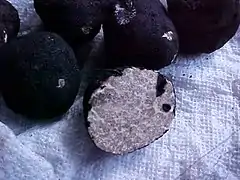| Leucangium carthusianum | |
|---|---|
 | |
| Leucangium carthusianum | |
| Scientific classification | |
| Kingdom: | |
| Division: | |
| Class: | |
| Order: | |
| Family: | |
| Genus: | |
| Species: | L. carthusianum |
| Binomial name | |
| Leucangium carthusianum | |
| Synonyms | |
| |
Leucangium carthusianum is a species of ascomycete fungus. It is commonly known as the Oregon black truffle.[1] It is found in the Pacific Northwest region of North America, where it grows in an ectomycorrhizal association with Douglas-fir. It is commercially collected, usually assisted by a specially trained truffle dog.[2] Mature fruiting bodies can be dug up mostly during winter, but the season can extend from September through April.
Description
On the outside, the fruit bodies are dark brown and rough to smooth. They are sometimes mistaken for coal lumps. Inside, the gleba is gray to brownish and separated into pockets by veins.[1] The odor is pungent and fruity, usually resembling pineapple.[1]
Edibility
Leucangium carthusianum is a good edible mushroom;[3] it can be prepared similarly to Oregon White and European truffles; it is typically shaved raw on top of a dish to add its complex musky aroma.[2]
See also
References
- 1 2 3 Trudell, Steve; Ammirati, Joe (2009). Mushrooms of the Pacific Northwest. Timber Press Field Guides. Portland, OR: Timber Press. p. 299. ISBN 978-0-88192-935-5.
- 1 2 Winkler, Daniel (2013). "Truffles of the Pacific Northwest". Fungi. 6 (4): 16–19.
- ↑ Phillips, Roger (2010). Mushrooms and Other Fungi of North America. Buffalo, NY: Firefly Books. p. 376. ISBN 978-1-55407-651-2.